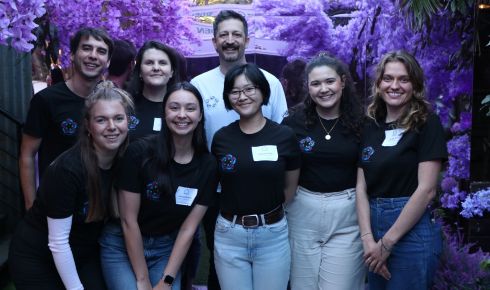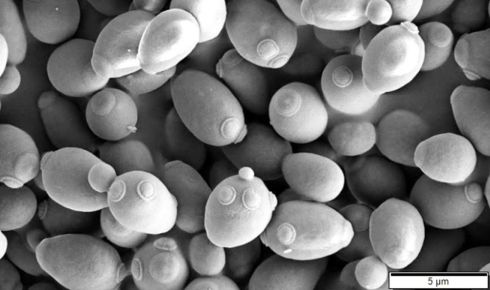Synthesising success

26 May 2025
Hugh Goold MRSB on the completion of the world’s first fully synthetic yeast genome
In January an international consortium of scientists announced that it had completed the construction of the final chromosome in the world’s first synthetic eukaryotic genome, ‘Sc2.0’.
The work completes a global project to design and construct a synthetic genome based on the yeast Saccharomyces cerevisiae. The synthetic Sc2.0 genome comprises 16 synthetic chromosomes designed with recoded stop codons, a range of genetic watermarks and junk DNA removed, plus a new-to-nature ‘neochromosome’ for all tRNA genes.
The recent completion of the final chromosome, synXVI, marks the end of the synthesis stage of the project, which began in 2006. It is seen as a landmark moment for synthetic biology: scientists say the work provides a template for the future engineering of plant and animal genomes, and will lead to new possibilities in the biomanufacturing of medicines, materials and other important resources.
Hugh Goold MRSB, a synthetic biologist and co-lead author of the paper on the final chromosome synXVI¹, tells The Biologist about the achievement and the progress he hopes will spin out from it.
“There is a huge amount of technical work in the paper, and I learned so much, but I think the key take-home is how far the field has progressed. At the outset of this project a few synthetic genomes had been completed, such as Pamela Silver’s recoding of Salmonella typhimurium, Drew Endy’s synthetic phage genome and Craig Venter’s famous minimal cell, JCVI-syn2.0. But now there are synthetic moss chromosomes, synthetic pan-genome neochromosomes and recoded genomes for virus immunity.
The number of papers on genome building techniques has grown enormously²,³. This signifies how much value people see in this technique, which would have sounded like something from a science-fiction novel in the 1990s. The technologies we employ have come forward hugely in the nine years I have been working on Sc2.0, and even more since the project started⁴.
I see a number of new directions this research will take. We’re going to start doing new organisms, and that’s going to be thrilling; I want to see us do this with an algal genome next. Another direction is refining the yeast 2.0 organism. For example, breaking the chromosomes into functions. Could we put all the basic cell functions on one chromosome? All the mating chromosomes on another?
If I’m interested in Fusarium cell wall biosynthesis, could we put all of the genes for that into a chromosome, replacing the yeast’s ones, and see how that works to combat plant diseases? Then we’re approaching a ‘modular’ yeast cell where we can just put in synthetic chromosomes for any given function to study.
 Hugh with his team
Hugh with his team
The final direction is closer to what the J Craig Venter Institute has been doing with its synthetic Mycoplasma genome, honing in on the essential genes. That’s important because of the implications for drug discovery and for fundamental cell biology. The number of genes that still have no known function in yeast is quite staggering.
The immediate challenge is to consolidate all the synthetic chromosomes the consortium has created into one cell – that’s ongoing. One of the original goals of the project was to have wild-type fitness in all the cells, so that when we consolidate all the strains it will be functional. The fitness of the full synthetic yeast cell remains to be seen, but yeast is incredibly plastic, so I’m hopeful it will eventually achieve wild-type fitness.
If I had unlimited resources, I would set up my own research institute to synthesise plant, mammalian and fungal genomes. Particularly by using these various approaches to inform plant biology, we can mitigate some of the major problems that we have with intensive agriculture.
If you look at how HIV medicine has progressed since the 1980s, it is now treated with a cocktail of three simple small molecule drugs that don’t have major side effects. I’d like to see that kind of thing happening with agricultural systems, where we don’t have herbicide tolerance growing through overuse of fertilisers and herbicides, where we can really start to approach agriculture in a new way. Approaching plant biology with this synthetic genomics angle could be really powerful in achieving some of those goals.
 Saccharomyces cerevisiae (image by Mogana Das Murtey and Patchamuthu Ramasamy)
Saccharomyces cerevisiae (image by Mogana Das Murtey and Patchamuthu Ramasamy)
I would build a modular algal genome with my collaborators, Kyle Lauersen and Jeffrey Moseley, as detailed in my 2023 paper on synthetic algae genomes⁵, which I loved writing.
Ultimately, new genome configurations can help make bioscience more predictable, more adaptable to engineering approaches and simpler. There are many exciting things, ranging from medical to agricultural discoveries, waiting to be unveiled by working with the fully assembled Sc2.0 genome. I know that all of the different members of the consortium are taking the projects in their own directions, so we’ll definitely see some really amazing outputs from this in the next 10 years.
Hugh Goold MRSB is a research scientist with New South Wales’ Department of Primary Industries and Regional Development, and an honorary research Fellow at Macquarie University, Australia.
Further reading
syntheticyeast.github.io
1) Goold, H. D. et al. Construction and iterative redesign of synXVI a 903 kb synthetic Saccharomyces cerevisiae chromosome. Nat. Commun. 16, 841 (2025).
2) Bosco, N. et al. KaryoCreate: A CRISPR-based technology to study chromosome-specific aneuploidy by targeting human centromeres. Cell 186, 1985–2001.e19 (2023).
3) Wang, K. et al. Defining synonymous codon compression schemes by genome recoding. Nature 539, 59–64 (2016).
4) Schindler, D. et al. Methodological advances enabled by the construction of a synthetic yeast genome. Cell. Rep. Methods 4(4), 10076 (2024) 1.
5) Goold, H. D. et al. The synthetic future of algal genomes. Cell Genom. 100505 (2024).


